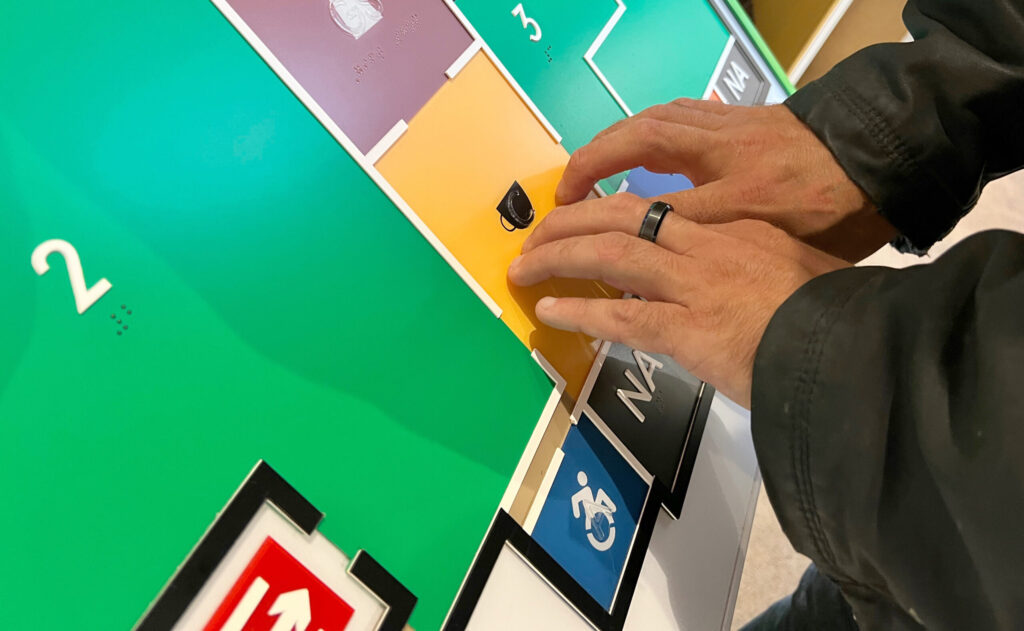
Direct Access has the immense privilege of contributing to the merge of two quickly synthesising worlds; technological innovation, and accessibility (which we are all about), with the launch of our new Tactile Braille Map Boards. But what is a Tactile Braille Map Board? How do they work?
To explain this, we first need to dive into the history of tactile graphics, Braille, and communication formats.
In its simplest form, a tactile map, or graphic, is a wayfinding tool that helps disabled people with visual impairments navigate public spaces. While many of us use our sense of sight to read paper maps, which are usually flat, a tactile map utilises Braille; a system of raised dots placed upon text, keys, and characters that instead allows us to use our sense of touch to decipher the information. With a history dating back over 200 years, Braille has been the primary access and communication tool used by severely visually impaired people for generations, particularly in the pre-computer/information age.
Braille remains a significant tool within our society at large, enjoying consistent use within education environments as a tool to help blind and visually impaired children learn how to read and write. But its incorporation into the design of map boards has not been standardised – which is a huge problem for accessibility and inclusion when we consider how a blind or visually impaired person might interact in built environments. After all, if you were unable to successfully read a map, would you not naturally avoid that environment? This problem generates unequal access and benefits neither disabled people nor facility owners, which is the issue that Direct Access has set out to solve with our innovative Tactile Map system.
Despite existing for two hundred years or so, Braille is very limiting in isolation. In fact, it is not even the preferred method of communication for a lot of blind and visually impaired people these days; as many would rather listen to a detailed audio description explaining the layout of a built environment rather than read/feel it on paper. This is where Direct Access Tactile Braille Map boards come into the picture. We set out to create a way finder that merges traditional methods with accessible tactile graphic technologies, offering pictorial information to people with all kinds of disabilities.

In our technology-driven world, carrying around a paper map is an inconvenience – so our disabled team has worked to design and deliver a new solution that can be accessed straight from a user’s mobile phone; a board that includes both audio described content about the map’s respective facility and Sign Language videos for deaf users, which explain the features of an environment in a simplistic fashion. In addition, our bespoke Tactile Map Sign Language videos draw attention to specific locations, saving users time when searching a traditional map board for their desired location. This is a huge benefit people to people with learning difficulties who might otherwise struggle to understand maps.
Direct Access’ Tactile Braille Maps can even be updated at the push of a button, utilizing dynamic QR code systems that allow owners to update information about their facility without facing the inconvenience of ordering a completely new map. Owners of the map simply email our team to update the layout of their bespoke map board, which we will then incorporate into the board’s sign language or audio-described content within 24 hours. Combining a variety of communication formats into one interactive kit, this dynamic map board also saves users the inconvenience of locating a map in a public space, by allowing people to scan it just once, and take the audio descriptions/sign language videos of a given built-environment wherever they go.
Of course, the map is still inclusive of the thousands of Braille users out there. Structurally speaking, the tactile maps boast Braille touch pads across all key characters, which are designed to display information in detail, but with an aesthetically simple design that allows them to be easily understood by people of all ages.
The Direct Access Tactile Braille Map can be used in a variety of environments, including schools, fairgrounds, shopping centers, railway stations, museums, entertainment and conference venues, and countless others.
In addition to increasing spatial awareness, the wide array of opportunities for application, and means of allowing disabled people to be involved in a wide variety of activities that excites us most about tactile formats, and accessible technologies in general. As a consultancy with a team comprised largely of disabled people, we cannot wait to introduce our Tactile Braille Map to the world and generate further inclusion and access for everyone.
Want to see how it works? Check out our Tactile Braille Map Board launch video below.